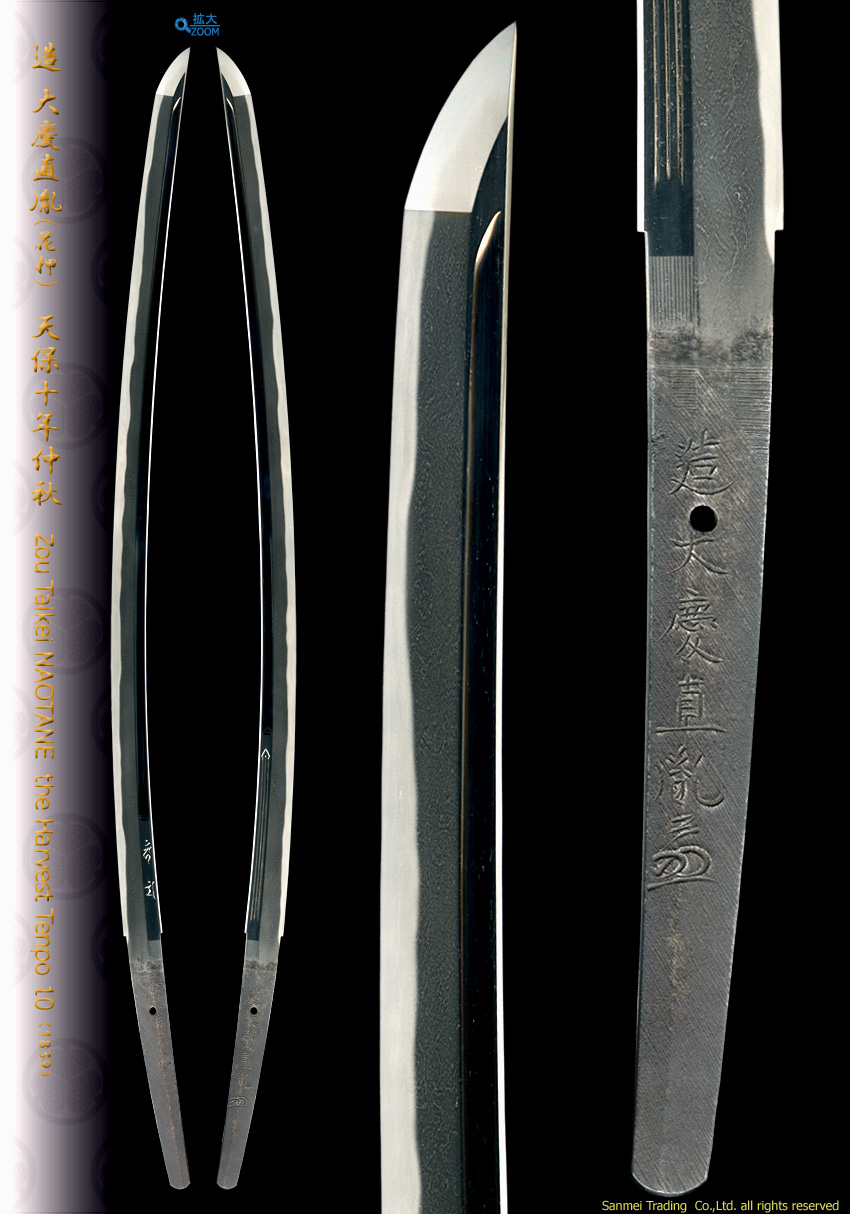Length of cutting edge 74.1cm Curvature 2.3cm Width of base 32.4mm Width of Yokote 23.1mm Thickness of base 7.9mm
Forging(Hada): Forging is conspicuous large Itame-hada mixing with Mokume mixing with flowing ware that appears mostly along quench side. Steel gives off darkish blue impression to cover with extremely thick, sparkling hard metal granules "Ji-nie" on Hira-ji surface. Darkish thick Nie lines of Chikei activity gushes where shows the mixtures of non-steel elements and uneven status of carbon steel to generate classical grace - fine steel heavy with significance of the beauty closely resembles ancient Nanbokucho period 14th century.
Temper(Hamon): Hamon is fine but a bit strong side Nie hard metal granules base, starting with irregular wave on base like "Yakidashi" then the range of small Gunome outlines with slanting Gunome. From the middle upper of blade, Gunome becomes larger that varies in height and shape then further upper area becomes shallow wavy calm down. The sparkling quench crystalline area add like a pearl luster impression with extreme deep "Noi" mist-like crystalline area. In the interior of temper, there works frequently with "Kinsen" bright curved threadlike areas, "Inazuma" thunderlike area and "Sunagashi" long lines of Nie. Thick Nie feet splashes into the cutting edge. Those activities of quench state are extremely vivid and bright standing out strikingly.
Temper of tip(Boshi): Boshi forms "MIDAREKOMI" irregular quench state with an intense "HAKIKAKE" blush up indication.
Tang(Nakago): Nakago is in UBU original, one peg hole. Osujikai (greatly slanting left) filemarks with horizontal Kesho filemark. Back ridge of Nakago is a bit well-rounded contour with Osujikai filemark. Bottom shape is double bevelled (Kurijiri) in full. There is a hidden inscription of Ichi-monji on the bottom. The signature is performed as Tachi style side, large and bohemian chiselled inscription of Zou Taikei NAOTANE 造大慶直胤 which is located along the ridge and the other side has the season and year, the Harvest Tenpo 10 天保十年仲秋.
The most superior sword smith NAOTANE 直胤, real name Shouji Minobei 庄司箕兵衛, with the pseudonym of Taikei 大慶 was one of the two greatest pupils under the master Suishinshi MASAHIDE 水心子正秀, equals to Hosokawa MASAYOSHI 細川正義.
NAOTANE 直胤 is highly renowned as the most skillful artisan for restoration works of the ancient Middle Ages.
He was born in Anei 7 (1778) of Yamagata castle town in Dewa province. He was happened to be born as "sickle's smith". However from a sheer desire to become a sword smith, he went up to Edo depending on the help of Suishinshi MASAHIDE of his senior and from the same town on about Kansei 10 (1798). He began to stand out a brilliant figure as a sword smith with his creative talent.
He got married to a daughter of charcoal dealer soon on about end of Kyowa (1803).
He worked for Akimoto of Tatebayashi feudal lord with his master "Suishinshi MASAHIDE". He enjoyed Chikuzen-daijo title 筑前大掾 on about Bunsei 5 (1822) then came up to Kyoto on Kanei 1 (1848) to enjoy an official title of Mino-no-suke 美濃介 from the Imperial Court. He sympathized the theory of restoration works from the Middle Ages and put into practice carefully with an elaborate research into fine steel over the land. During long research and practice in his life over half century, he had acquired every 5 different techniques of Yamashiro, Yamato, Bizen, Soushu and Mino school. Finally he had surpassed his master in the restoration works especially surpassed the other in skill of works under Bizen technique in middle-aged then Soushu schools in his prime of life. He lived in Okachimachi (now in Taitou-ku Tokyo) later in life, passing 27th day, the 5th month Ansei 4 (1857), was 79 years old, buried in Houzenji in Asakusa, Tokyo.
The subject heroic Tachi-style sword of great spirit was made on Tenpo 10 (1839), when he was matured age of 61 years old. Original carvings of Bo-hi, Suken and the two Bonji Sanskrit characters, these were performed by NAOTANE himself. In view of the tang (Nakago), the chiselled inscription is energetic, large of majestic view against elaborately made filemark with a strong confident manner. The subject katana proves that he is the top ranked, top skilled sword maker in Shin-shin-to period and this is surely one of his most splendid masterpiece works of Soushu school which is strongly influenced on the work of SADAMUNE 貞宗. Excellent taste of patina of Nakago and almost mint and healthy condition of the blade.
An fresh top quality polish/Condition scale: mint-excellent (using a scale of mint-excellent-very good-good-fair-poor).
Double layer gold foiled Habaki collar, preserved in a Shira saya plain wood mounting.
reference data:
Honma Junji/Satou Kanichi, NIHONTO TAIKAN SHINTO-HEN 2, Otsuka Kogei sha, 1969
Three katanas of NAOTANE are nominated as Juyo-Bijutsuhin (the important cultural property), whereas 4 for Yamanoura KIYOMARO, 2 for Sa YUKIHIDE and 1 for Suishinshi MASAHIDE.

